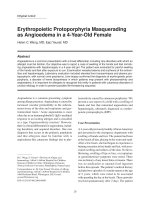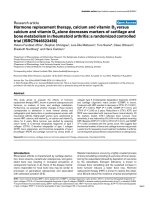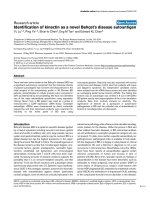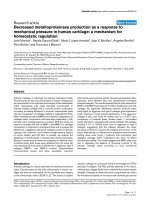Báo cáo y học: "Hyperbaric oxygen therapy as an adjunctive treatment for sternal infection and osteomyelitis after sternotomy and cardiothoracic surgery" pptx
Bạn đang xem bản rút gọn của tài liệu. Xem và tải ngay bản đầy đủ của tài liệu tại đây (386.38 KB, 5 trang )
RESEARCH ARTIC LE Open Access
Hyperbaric oxygen therapy as an adjunctive
treatment for sternal infection and osteomyelitis
after sternotomy and cardiothoracic surgery
Wen-Kuang Yu
1
, Yen-Wen Chen
1,2
, Huei-Guan Shie
1
, Te-Cheng Lien
1,2
, Hsin-Kuo Kao
1,2
and Jia-Horng Wang
1*
Abstract
Purpose: A retrospective study to evaluate the effect of hyperbaric oxygen (HBO2) therapy on sternal infection
and osteomyelitis following median sternotomy.
Materials and methods: A retrospective analysis of patients who received sternotomy and cardiothoracic surgery
which developed sternal infection and osteomyelitis between 2002 and 2009. Twelve patients who received
debridement and antibiotic treatment were selected, and six of them received additional HBO2 therapy.
Demographic, clinical characteristics and outcome were compared between patients with and without HBO2
therapy.
Results: HBO2 therapy did not cause any treatment-related complication in patients receiving this additional
treatment. Comparisons of the data between two study groups revealed that the length of stay in ICU (8.7 ± 2.7
days vs. 48.8 ± 10.5 days, p < 0.05), duration of invasive (4 ± 1.5 days vs. 34.8 ± 8.3 days, p < 0.05) and non-
invasive (4 ± 1.9 days vs. 22.3 ± 6.2 days, p < 0.05) positive pressure ventilation were all significantly lower in
patients with additional HBO2 therapy, as compared to patients without HBO2 therapy. Hospital mortality was also
significantly lower in patients who received HBO2 therapy (0 case vs. 3 cases, p < 0.05), as compared to patients
without the HBO2 therapy.
Conclusions: In addition to primary treatment with debridement and antibiotic use, HBO2 therapy may be used as
an adjunctive and safe treatment to improve clinical outcomes in patients with sternal infection and osteomyelitis
after sternotomy and cardiothoracic surgery.
Keywords: hyperbaric oxygen, sternal infection, osteomyelitis, sternotomy, Cardiothoracic surgery
Introduction
Patients with sternal infection and osteomyelitis after ster-
notomy and cardiothoracic surgery are unc ommo n, but
the se serious complications could increase postoperative
mortality, morbidity and medical cost [1,2]. Ischemia and
hypoxia are postulated as the mechanism resulting in
development of sternal infection and osteomyelitis [3,4];
however, the current primary treatment only focuses on
early debridement and antibiotic use [5].
Hypobaric ox ygen (HBO2) thera py, the administration
of 100% oxygen at 2 to 3 absolute atmosphere pressure
(ATA), has been widely used in the treatment of various
problem wounds and for refractory osteomyelitis [6,7].
Mechanisms of HBO2 therapy include reversing hypoxia,
reducing local edema, improving host immunity, enhan-
cing antibiotic activity [8,9]. There are only few reports
about the additional HBO2 therapy for patients who
develop sternal osteomyelitis after ste rnotomy. Most of
the results are effective and successful [10,11]. The aim of
this retrospective study was to evaluate t he efficacy of
HBO2 therapy in patients with sternal infection and osteo-
myelitis after sternotomy and cardiothoracic surgery.
Methods and materials
During January 1
st
, 2002 to December 31
th
2009, twelve
patients who developed sternal infection and osteomyelitis
* Correspondence:
1
Department of Respiratory Therapy, Taipei Veterans General Hospital, Taipei,
Taiwan
Full list of author information is available at the end of the article
Yu et al. Journal of Cardiothoracic Surgery 2011, 6:141
/>© 2011 Yu et al; licensee BioMed Central Ltd. This is an Open Access article distributed under the terms of the Creative Commons
Attribution Lice nse ( which permits unrestri cted use, distribution, and reproduction in
any m edium, provided the original work is properly cited.
following sternotomy and cardiothoracic surgery at Taipei
Veterans General Hospital were recruited. The study
was approved by the Institutional Review Board of the
Taipei Veterans General Hospital (approval number,
201009015IC). All study data were collected retrospec-
tively, so informed consent was not required.
The diagnosis of organ/space sternal surgical site infec-
tion(SSI) was according to the Center for Disease Control
(CDC) criteria: (1) the sternal SSI occurs after sternotomy
and cardiothoracic surgery; (2) the infection appears to be
related to the operation and could involve any part of the
anatomy other than the incision which was opened or
manipulated during the operation (organs or spaces).
Furthermore, at least one of the following criteria is
required: (1) purulent drainage from the organ/space of
sternal surgical site; (2) organism isolated from an asepti-
cally obtained culture of fluid or tissue in the organ/space
of sternal surgical site; (3) an abscess or other evidence of
infection involving the organ/space of sternal surgical site
found on direct examination; (4) diagnosis of organ/space
SSI by a surgeon or attending physician [12]. In addition,
sternal osteomyelitis was documented by computer tomo-
graphy of chest, surgical debridement pathology or osteo-
myelitis scans.
All patients were treated with empiric antibiotics initially
and then guided by culture report and antibiotic suscept-
ibility tests. Early debridement, daily antiseptic irrigation
anddressingchangewereperformed.Aftertheinfection
was under control, reconstruction of the wound with pec-
toralis or rectus muscle and omental flap rotation was per-
formed at the decision of the clinical physician. HBO2
therapy was performed in a multiplace chamber (HTK
1500/BS, Drägen, Siemens, Germany). Each session was
120 minutes long including three phases: compression,
oxygen breath and decompression. Compression and
decompression were performed with room air at a rate of
0.1 ATA per minute. At oxygen breath phase, all patients
breathed 100% oxygen under 2.5 ATA for 90 minutes
through a face mask that was fit well and secured with
head straps. During the treatment period, patients were
observed closely for acut e illness or any complications.
HBO2 therapy sessions were daily from Monday to Friday
with a break of 2 days. The total number of sessions of
HBO2 therapy performed based on clinical outcome and
at the discretion of t he clinical physician.
Statistical analysis
Statistical analysis was done using SPSS version 18.0
(SPSS Inc., Chicago IL). Co ntinuous variables were
expressed as the mean ± standard deviation (SD). Con-
tinuous variables were compared with Wil coxon ’srank
sume test and categorical variables were compared by
Fishers exact test. p < 0.05 w as considered statistically
significant.
Results
During the study period, 12 patients (mean age 59 ±
4.5 years) fulfilling the entry criteria were selected. Among
these patients, 7 patients received coronary arterial bypass
surgery, 3 patients received thymectomy, 1 patient
received mitral valve replacement and 1 patient received
type A aortic dissection repair. They received computer
tomography of chest (n = 8), pathologic surgical debride-
ment (n = 3) or osteomyelitis scans (n = 7) for the diagno-
sis of sternal osteomyelitis. All patien ts received primary
treatments with debridement and empiric antibiotics treat-
ment, and then guided by antibiotic susceptibility tests. Six
of them received additional HBO2 therapy. The others did
not received HBO2 therapy because of the insurance or
risk of HBO2 therapy. The characteristics of the study
population are presented in Table 1 and there was no sig-
nificant difference between these two groups. The bacter-
iology data from sternal wound/pus, pleu ral effusion and
blood are listed in Table 2. Staphylococcus species were the
most common pathogens of sternal wound infection
(11/1 2, 91.7%) and bacteremia (5/6, 83 .3%). Mixed infec-
tion due to Gram-positive and Gram-negati ve pathogens
was also identified in 2 patients (2/12, 16.7%). Mycobacter-
ium tuberculosis was found in one sternal pus/wound
pathogen. HBO2 therapy did not cause any treatment-
related complication in the study patients who received
this additional treatment. Besides, patients breathed with
room air when i nitiation ofHBO2therapyanddidnot
receive mechanical ventilation, sedative or inotropic medi-
cation during HBO2 therapy. Total and average debride-
ment duration, debridement frequency, hospital admission
frequency and length of hospital stay were not significantly
Table 1 Characteristiscs of patients in HBO2 and control
group
HBO2(n = 6) Control(n = 6) p
Age, years 54.7 ± 7.4 63.3 + 5.5 0.267
Female 1(%17) 2(%34) 0.500
Smoke 3(%50) 3(%50) 0.716
Body mass index (kg/m
2
) 24.7+1.5 24.7+1.5 0.749
Coronary artery disease 3(%50) 3(%83) 0.273
Hypertension 3(%50) 3(%50) 0.716
Atrial fibrillation 1(%17) 1(%17) 0.773
Myocardial infarction history 1(%17) 4(%67) 0.121
Hyperlipidemia 1(%17) 2(%34) 0.500
Congestive heart failure 0 2(%34) 0.227
COPD 1(%17) 1(%17) 0.773
Myasthenia gravis 2(%34) 0 0.227
Diabetes mellitus 1(%17) 3(%50) 0.333
Chronic renal insufficiency 0 1(%17) 0.600
Uremia 1(%17) 1(%17) 0.773
Body mass index: the weight in kilogram s divided by the square of the height
in meters COPD: chronic obstructive pulmonary disease
Yu et al. Journal of Cardiothoracic Surgery 2011, 6:141
/>Page 2 of 5
different between HBO2 therapy and control group. Most
importantly, length of ICU stay (8.7 ± 2.7 days vs. 48.8 ±
10.5 days, p < 0.05), duration of invasive mechanical venti-
lation (MV) (4 ± 1.5 days vs. 34.8 ± 8.3 days, p < 0.05) and
duration of noninvasive positive pressure ventilation (NIV)
(4 ± 1.9 days vs. 22.3 ± 6.2 days, p < 0.05) were signifi-
cantly reduced in HBO2 therapy group (Table 3). In addi-
tion, hospital death (0 person vs. 3 persons, p < 0.05) w as
significantly lower in HBO2 therapy group (Table 4). The
causes of death in the control group were ischemic bowel
disease (n = 1), acute pancreatitis (n = 1) and mediastinitis
(n = 1).
Discussion
The incidence of sternal infection and osteomyelitis in
patients undergoing sternotomy for cardiothoracic surgery
is not common- stated as being less than 4% in several
reports; however, it is a serious complication that increases
the length of hospital stay, short-term and long term mor-
tality, and medical cost [4, 13]. In the current study, we
demonstrated that in patients with sternal infection and
osteomyelitis after sternotomy and cardiothoracic surgery,
HBO2 therapy could be an adjunctive treatment to
improve clinical outcomes including the length of ICU
stay, duration of MV and NIV support, complications dur-
ing hospital stay, and hospital mortality.
Risk factors for deep sternal wound infection and
osteomyelitis after median sternotomy have been
reported that included: (1) preoperative factors: male,
chronic obstructive pulmonary disease, diabetes, New
York Heart Association congestive heart failure class,
reoperation and obesity; (2) intraoperative factors: cor-
onary artery bypass grafting, prolonged cardiopulmonary
bypass time and duration of surgery; (3) postoperative
factors: excessive postoperative bleeding, postoperative
inotropic support and prolonged time (>48 hours) on
mechanical ventilation [14-18]. In our study, although
patients in the control group compared to HBO2 group
had more above-mentioned risk factors, these differences
did not reach statistical significance. However, the poten-
tial influence by these risk factors might still play a role
on the patient outcome. Importantly, patients with the
co-morbidity of congestive heart failure have been men-
tioned the risk for acute pulmonary edema after HBO2
therapy [19]. Ther efore, HBO2 therapy s hould be cau-
tious when be applied to these patients.
The pathophysiology of sternal wound infection and
osteomyelitis is hypoxia and ischemia [3,4]; therefore, the
administration of HBO2 therapy has theoretical benefit for
these patients. However, there are only few case reports
and non-randomized studies about the use of HBO2 ther-
apy in this patient population. Recently, Higuchi et al. pre-
sented 4 patients with sternal osteomyelitis after lung
transplantation who received surgical debridement, anti-
microbial treatment and adjunctive HBO2 therapy [10].
Three of them improved significantly and the authors con-
cluded that HBO2 therapy was safe and effective for the
management of infection complication. Barili et al also
conducted a prospective nonrandomized study to investi-
gate the effect of HBO2 therapy o n organ/space sternal
surgical site infection (SSI) following cardiothoraci c sur-
gery [20]. A total of 34 patients who developed organ/
space sternal SSI a fter cardiac surgery were enrolled and
divided into two groups according to whether HBO2 ther-
apy was offered or not. The relapsing, infection rate, the
duration of intravenous antibiotic use and total hospital
stay were significantly lower in patients with HBO2 ther-
apy than those without HBO2 therapy. In o ur study, we
further identified that HBO2 therapy alleviated the burden
of cr itical care by shortening the length of ICU stay, and
duration of MV and NIV s upport. Furthermore, it also
reduced complications during hospi tal stay and mortality
in patients with sternal infection and osteomyelitis after
sternotomy and cardiothoracic surgery. Although the total
length of hospital stay and total debridement frequency
were not significantly different between the HBO2 therapy
and control group, patients in HBO2 group tended to
receive more debridement frequencies and have more hos-
pital admissions that might contribute to longer length
hospital stay and better outcome.
The current treatment for sternal infection and osteo-
myelitis includes early recognition, early debridement,
collection of specimens for ba cteria pathogen, use of
broad-spectrum antibiotics and a change in antibiotics
Table 2 Causative organisms of patients in HBO2 and
control group
HBO2 Control
Sternal pus/
wound
Methicillin sensitive Staphylococcus
aureus
01
Methicillin resistent Staphylococcus
aureus
5* 4
Coagulase negative Staphylococcus
species
01*
Acinectobacter baumannii 01*
Klebsiella pneumoniae 1* 0
Escherichia coli 1* 0
Mycobacterium tuberculosis 10
Pleural effusion Methicillin resistent Staphylococcus
aureus
12
Blood Methicillin resistent Staphylococcus
aureus
23
Acinectobacter baumannii 01*
Serratia marcescens 01*
Proteus mirabilis 01*
Fungus 0 1*
* mixed infection
Yu et al. Journal of Cardiothoracic Surgery 2011, 6:141
/>Page 3 of 5
based on the culture result of the sensitivity test. When
the patient’s infection is under control, reconstruction of
the wound should be institut ed, including rewiring, and
pectoralis or rectus muscle and omental flap rotation
[21-23]. HBO2 therapy might offer additional biochem-
ical and cellular effects. With the administration of
HBO2 therapy, the partial oxygen pressure in the wound
increases and promotes collagen matrix formation, angio-
genesis, osteoclast/osteoblast activity and bone union
[24-26]. Increased oxygen tension improves neutrophil
ability to kill bacteria. Some antibiotics such as aminogly-
cosides, fluoroquinolones, vancomycin and sulfona mides
have a synergistic effect when combined with HBO2 for
the treatment of bacterial infection [9]. HBO2 itself also
acts as an antibiotic agent against a broad spe ctrum of
Gram-positive and Gram-negative bacteria [9]. These
above-ment ioned effects of HBO2 therapy might explain
how adju nctive HBO2 therapy provides ad ditional bene-
fits to patients with sternal infection and osteomyelitis
and improves the clinical outcomes of such patients.
The timing of HBO2 therapy for SSI and sternal osteo-
myelitis after sternotomy has been discussed. Higuchi et
al. reported the initiation of HBO2 therapy for patients
with persistent osteomyelitis after standard treatment [10].
Barili et al started early HBO2 therapy after the diagnosis
of sternal surgical site infection [20]. Both studies demon-
strated the adjunctive benefit of HBO2 therapy. In our
study, the decision of HBO2 therapy was based on clinical
physicians, range from 2 weeks to months aft er the diag-
nosis of sternal osteomyelitis. However, the timing of
HBO2 therapy for sternal osteomyelitis to gain maximum
benefit requires further investigation.
Although the microbiologic pathogens from the sternal
pus/wound, pleural effusion and blood are diverse,
Gram-positive cocci remain the most common pathogens
in our retrospective study which is consistent with other
studies [27,28]. Interesting, mycobacterium tuberculosis
was foun d in one sternal pus/wound pathogen. Reactiva-
tion of pulmonary or mediastinal lymph node tuberculo-
sis, contamination of the operation field, and exogenous
exposure persons with active pulmonary tuberculosis
may hypothesize tuberculosis infection after cardiothor-
acic surgery [29,30]. The patient with sternal wound
infection of mycobacterium tuberculosis received surgical
debridement, combination antituberculous agent treat-
men t an d HBO2 the rapy and was finally discharged . It is
important to note that some of the patients with sternal
infection and osteomyelitis developed bacteremia (2/6 in
HBO2 therapy group, 4/6 in cont rol gro up) which might
worsen the prognosis of patients. Based on our observa-
tions of this study, HBO2 therapy might improve sternal
infection and reduce the occurrence of bacteremia.
Limitations
Our study had several limitations that are worth noting.
This study was retros pective in nature; therefore certain
data might have been missing or poorly documented.
Second, the number of patients in this study was small.
Third, we only focused on the clinical outcomes of the
study patients; therefore, the local effects of HBO2 ther-
apy, such as tissue oxygenation, angiogenesis, and osteo-
clast/osteoblast activity were not observed.
Conclusion
HBO2 counteracts tissue hypoxia by elevating tissue
oxygen partial pressure, promotes wound healing, has
the synergistic effect when combined with some antibio-
tics and prevents infection. In this study, all patients
Table 3 Operative and postoperative details in HBO2 and control group
HBO2 Control p
Total debridement operation time (minutes) 437 ± 81.4 355 ± 82.9 0.873
Average debridement operation time (minutes) 94 ± 21.6 98.6 ± 16 0.522
Total debridement frequency 5.5 ± 1.5 3.8 ± 1.0 0.326
APACHE II score 19.7 ± 7.7 18.7 ± 3.7 0.749
Duration in ICU (days) 8.7 ± 2.7 48.8 ± 10.5 0.004
Duration with MV use (days) 4 ± 1.5 34.8 ± 8.3 0.008
Duration with NIV use (days) 4 ± 1.9 22.3 ± 6.2 0.015
HBO2 frequency 21.3 ± 2.5 0 <0.001
Hospital admission frequency 2.8 ± 0.4 2 ± 0.2 0.127
Total hospital length of stay (days) 151 ± 21 138 ± 37 0.757
MV: invasive mechanical ventilation
NI: non-invasive mechanical ventilation
Table 4 Outcome of patients in HBO2 and control group
HBO2 Control p
Death 0 3 0.046
Complications 0.9 ± 2.3 0.7 ± 5 0.059
Complication: seizure/stroke, acute myocardial infarction/arrhythmia,
bacteremia, pneumonia/empyema, acute pancreatitis, ischemic bowel disease,
upper gastrointestinal tract bleeding, hyperglyc emia, acute renal failure
Yu et al. Journal of Cardiothoracic Surgery 2011, 6:141
/>Page 4 of 5
who received HBO2 therapy as an adjunctive treatment
for post-cardiot hor acic surgery related sternal infection
and osteomyelitis achieved a favorable result. We s ug-
gest a combination of aggressive surgical debridement,
antibiotic treatment and adjunctive HBO2 therapy for
patients who develop sternal infection and o steomyelitis
after cardiothoracic surgery.
Acknowledgements
The authors are grateful to Steven R. Kaufman, a marketing director of
Scandinavian Health Limited Group, for his help in language editing.
Author details
1
Department of Respiratory Therapy, Taipei Veterans General Hospital, Taipei,
Taiwan.
2
National Yang-Ming University School of Medicine, Taipei, Taiwan.
Authors’ contributions
WKY and YWC both participated in the design of the study and drafted the
manuscript. HGS and TCL both obtained data and performed the statistical
analysis. HKK and JHW both participated in critical revision of the
manuscript. All authors read and approved the final manuscript
Competing interests
The authors declare that they have no competing interests.
Received: 2 August 2011 Accepted: 17 October 2011
Published: 17 October 2011
References
1. Braxton JH, Marrin CA, McGrath PD, Ross CS, Morton JR, Norotsky M,
Charlesworth DC, Lahey SJ, Clough RA, O’Connor GT, Northern New
England Cardiovascular Disease Study Group: Mediastinitis and long-term
survival after coronary artery bypass graft surgery. Ann Thorac Surg 2000,
70:2004-7.
2. Muñoz P, Menasalvas A, Bernaldo de Quirós JC, Desco M, Vallejo JL,
Bouza E: Postsurgical Mediastinitis: A Case-Control Study. Clin Infect Dis
1997, 25(5):1060-4.
3. Francel TJ, Dufresne CR, Baumgartner WA, O’Kelley J: Anatomic and clinical
considerations of an internal mammary artery harvest. Arch Surg 1992,
127:1107-11.
4. Mills C, Bryson P: The role of hyperbaric oxygen therapy in the treatment
of sternal wound infection. Eur J Cardiothorac Surg 2006, 30:153-159.
5. De Feo M, Gregorio R, Della Corte A, Marra C, Amarelli C, Renzulli A, Utili R,
Cotrufo M: Deep sternal wound infection: the role of early debridement
surgery. Eur J Cardiothorac Surg 2001, 19:811-816.
6. Zamboni WA, Browder LK, Martinez J: Hyperbaric oxygen and wound
healing. Clin Plastic Surg 2003, 30:67-75.
7. Undersea & Hyperbaric Medical Society. [ />page=Indications].
8. Hunter S, Langemo DK, Anderson J, Hanson D, Thompson P: Hyperbaric
Oxygen Therapy for Chronic Wounds. Adv Skin Wound Care 2010,
23(3):116-119.
9. Cimşit M, Uzun G, Yildiz S: Hyperbaric oxygen therapy as an anti-infective
agent. Expert Rev Anti Infect Ther 2009, 7(8):1015-1026.
10. Higuchi T, Oto T, Millar IL, Levvey BJ, Williams TJ, Snell GI: Preliminary
report of the safety and efficacy of hyperbaric oxygen therapy for
specific complications of lung transplantation. J Heart Lung Transplant
2006, 25(11):1302-1306.
11. Shields RC, Francis C, Nichols FC, Buchta WG, Claus PA: Hyperbaric oxygen
therapy for chronic refractory osteomyelitis of the sternum. Ann Thorac
Surg 2010, 89:1661-3.
12. Mangram AJ, Horan TC, Pearson ML, Silver LC, Jarvis WR: Guideline for
prevention of surgical site infection, 1999. Hospital Infection Control
Practices Advisory Committee. Infect Cont Hosp Ep 1999, 20(4):247-278.
13. Kappstein I, Schulgen G, Fraedrich G, Schlosser V, Schumacher M,
Daschner FD: Added hospital stay due to wound infections following
cardiac surgery. Thorac Cardiovasc Surg 1992, 40:148-51.
14. Culliford AT, Cunningham JN, Zeff RH, Isom OW, Teiko P, Spencer FC:
Sternal and costochondral infections following open-heart surgery: a
review of 2,594 cases. J Thorac Cardiovasc Surg 1976, 72:714-726.
15. Demmy TL, Park SB, Liebler GA, Burkholder JA, Maher TD, Benckart DH,
Magovern GJ Jr, Magovern GJ Sr: Recent experience with major sternal
wound complications. Ann Thorac Surg 1990, 49:458-462.
16. Borger MA, Rao V, Weisel RD, Ivanov J, Cohen G, Scully HE, David TE: Deep
sternal wound infection: risk factors and outcomes. Ann Thorac Surg
1998, 65:1050-1056.
17. The Parisian Mediastinitis Study Group: Risk factors for deep sternal
wound infection after sternotomy: a prospective, multicenter study. J
Thorac Cardiovasc Surg 1996, 111:1200-1207.
18. Newman LS, Szczukowski LC, Bain RP: Suppurative mediastinitis after
open heart surgery. Chest 1988, 94:546-53.
19. Weaver LK, Churchill S: Pulmonary edema associated with hyperbaric
oxygen therapy. Chest 2001, 120(4):1407-1409.
20. Barili F, Polvani P, Topkara VK, Dainese L, Cheema FH, Roberto M, Naliato M,
Parolari A, Alamanni F, Biglioli P: Role of hyperbaric oxygen therapy in the
treatment of postoperative organ/space sternal surgical site infections.
World J Surg 2007, 31:1702-1706.
21. Klesius AA, Dzemali O, Simon A, Kleine P, Abdel-Rahman U, Herzog C,
Wimmer-Greinecker G, Moritz A: Successful treatment of deep sternal
infections following open heart surgery by bilateral pectoralis major
flaps. Eur J Cardiothorac Surg 2004, 25:232-3.
22. Oh AK, Lechtman AN, Whetzel TP, Stevenson TR: The infected median
sternotomy wound: management with the rectus abdominis
musculocutaneous flap. Ann Plast Surg 2004, 52:367-70.
23. Schroeyers P, Wellens F, Degrieck I, de Geest R, Van Praet F, Vermeulen Y,
Vanermen H: Aggressive primary treatment for poststernotomy acute
mediastinitis: our experience with omental- and muscle flaps surgery.
Eur J Cardiothorac Surg 2001, 20:743-6.
24. Hopf HW, Gibson JJ, Angeles AP, Constant JS, Feng JJ, Rollins MD, Zamirul
Hussain M, Hunt TK: Hyperoxia and angiogenesis. Wound Repair Regen
2005, 13(6):558-564.
25. Sawai T, Niimi A, Takahashi H, Ueda M: Histologic study of the effect of
hyperbaric oxygen therapy on autogenous free bone grafts. J Oral
Maxillofac Surg 1996, 54:975-981.
26. Godman GA, Chheda KP, Hightower LE, Perdrizet G, Shin DG, Giardina C:
Hyperbaric oxygen induces a cytoprotective and angiogenic response in
human microvascular endothelial cells. Cell Stress Chaperones 2010,
15:431-442.
27. Mekontso Dessap A, Vivier E, Girou E, Brun-Buisson C, Kirsch M: Effect of
time to onset on clinical features and prognosis of post-sternotomy
mediastinitis. Clin Microbiol Infect 2011, 17(2):292-9.
28. Brook I: Microbiology of postthoracotomy sternal wound infection. J Clin
Microbiol 1989, 27(5):806-807.
29. Sipsas NV, Panayiotakopoulos GD, Zormpala A, Thanos L, Artinopoulos C,
Kordossis T: Sternal tuberculosis after coronary artery bypass graft
surgery. Scand J Infect Dis 2001, 33:387-388.
30. Achouh P, Aoun N, Hagege A, Fabiani JN: Mediastinitis due to
Mycobacterium tuberculosis after a redo open heart surgery. J
Cardiovasc Surg 2005, 46(1):93-94.
doi:10.1186/1749-8090-6-141
Cite this article as: Yu et al.: Hyperbaric oxygen therapy as an
adjunctive treatment for sternal infection and osteomyelitis after
sternotomy and cardiothoracic surgery. Journal of Cardiothoracic Surgery
2011 6:141.
Yu et al. Journal of Cardiothoracic Surgery 2011, 6:141
/>Page 5 of 5









